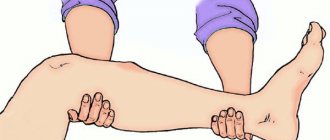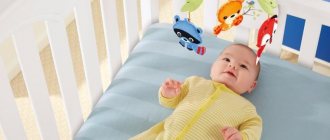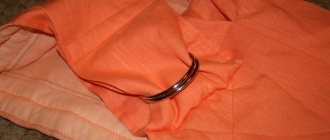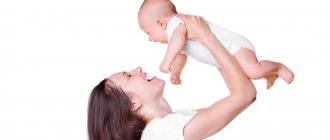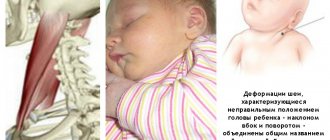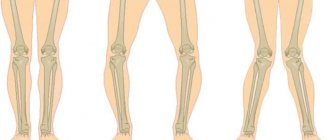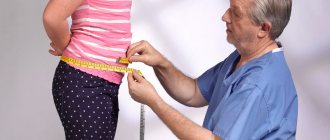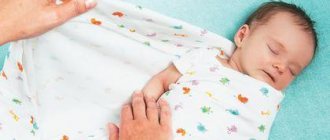A knitted sling scarf is an ergonomic baby carrier, made in the form of a strip of knitted fabric about 5 m long and 40-70 cm wide.
The knitted sling is popular among parents due to:
- softness and elasticity of the fabric: knitwear stretches in all directions of the fabric, so it easily adapts to the changing sizes of the child;
- low price: this is the cheapest of all slings, so despite its shortcomings, a knitted scarf is the most popular of all slings.
What are the disadvantages of a knitted scarf?
Before we talk about how to choose a knitted sling, it is necessary to mention that this carrier has quite a lot of disadvantages, which is why we much more often recommend purchasing a more expensive, but much more practical carrier for a newborn (for example, a woven scarf sling, a May-sling or adjustable ergo backpack):
- restriction on the child’s age: knitwear stretches a lot, so around 5-6 months it becomes difficult to carry a child in it, you will have to buy another carrier, a woven sling or an ergo-backpack;
- hotness : this is the hottest of all carriers, even with thin knitwear the child is in three layers of fabric, so in summer it is very difficult to use such a carrier;
- limited adjustment: the main winding of the knitwear “cross under the pocket” is formed immediately, before the child is positioned in it, so winding flaws are difficult and sometimes impossible to correct, which can affect the not entirely correct positioning of the child in the scarf. In this regard, woven slings-scarves are much easier to adjust in winding, because the child is placed in it in the middle of the process of putting on the sling, and not at the end.
However, a knit sling is a much better alternative for a newborn compared to so many non-ergonomic carriers (such as kangaroo carriers, pseudo-pocket slings and non-adjustable baby carriers), as well as knockoff brands like Ergobaby, which sell for the same price as a good knitted one. sling Let's look at what to look for when choosing it.
Sling width
The main thing you need to pay attention to is the width of the fabric . The optimal width, suitable for a child from birth until six months, when they stop using knitwear, is at least 60cm, and preferably 65cm. But most manufacturers have a width of about 40-50cm, which is not enough for winding a “cradle” and for an older child. Why is that?
The fact is that knitted fabric in factories is produced with a width of 150 cm, so manufacturers, trying to reduce fabric leftovers and the cost of the scarf, cut it into 3 parts along the edge, so that the width of each sling is no more than 50 cm. If you make it as needed, 60cm, there will be a 30cm strip of fabric that cannot be used, and from the same amount of knitwear you will get not 3, but 2 slings. But you as a client should not worry about this!
Do not buy a narrow knitted scarf, it is uncomfortable and even dangerous for the child.
Elasticity and fabric composition
“Elasticity” refers to the ability of a fabric to regain its shape after being stretched. This is extremely important for a sling, which constantly stretches under the weight of the child, and with low elasticity it will very quickly stretch and become unusable. To increase resistance to loss of shape, a little elastane is added to the fabric, but not more than 5%, otherwise the fabric will be too dense. We consider the composition 95% cotton, 5% elastane ideal for a knitted sling.
However, most manufacturers use 100% cotton; we do not really recommend this fabric. In addition to being more prone to stretching over time, such fabric has poorer stretch, so the sling will be more difficult to adjust. In addition, pure cotton knitwear usually wears out a lot (it quickly becomes covered with pills) and wrinkles.
In addition to cotton and cotton with elastane, various viscose (regular, bamboo, eucalyptus, etc.) are sometimes used in slings. This composition gives the fabric a special silkiness and softness, but as a rule, such slings are thinner and have worse support than cotton.
We don’t even consider knitted slings with polyester in the composition (for example, fleece); synthetic fabric cannot be used for a child!
Fabric quality
As a rule, for slings they use cuffed, smooth knitwear, with a clearly defined front and back side. The stockinette stitch almost does not stretch in length, but it stretches well in width.
However, such fabric can be of three grades, depending on the quality of the yarn used: pene, ring (carde) and open end.
- Penye: yarn consists of long fibers (up to 80 mm), this is the highest quality and most expensive raw material, since it is the length of the fibers that determines the ability of the material to keep its shape. This fabric will not roll up and will withstand numerous washes and long-term wear.
- Ring/Carde: average yarn length - 27-35 mm. Fabric made from such yarn will be less durable and elastic.
- Open end: short yarn - its fiber length is less than 27 mm. It also includes remnants of previous types of yarn. It is used for those products where the shape is not required to be perfectly maintained.
Unscrupulous manufacturers (especially those made in China) can use cheap open-end and ring knitwear to reduce the price, but such a sling will be practically disposable and will become unusable after the first wash. Choose only slings made from fabric of “pene” quality! If this characteristic is not indicated in the sling description, please clarify, because this is a very important point!
Density and thickness of fabric
Knitwear can be very different in thickness and density:
- thin knitwear: the fabric is thin, suitable only for clothing, translucent when stretched. This fabric is poorly suited for wearing children; moreover, it is dangerous to carry a child in thin fabric, because... There is a risk of fabric tearing! Cannot be used!
- medium-weight knitwear: the most optimal thickness for a knitted scarf. The thickness is sufficient to carry a child until about six months, but it will not be too hot, given the three-layer winding. The best option!
- thick knit: thick (often reversible) fabric. The manufacturer can position such slings as more universal in terms of age. Thick knitwear can actually be used until the child is one year old, but it will be very hot in such fabric, especially in summer! Therefore, we do not recommend such slings; if you need a truly universal scarf, it is better to purchase a woven sling, a May-sling or an ergo-backpack from birth. Acceptable, but not optimal.
Backpack
The device is distinguished by wide straps that are attached to the back parallel or crosswise. The backrest is equipped with a headrest and bolsters. Comfortable wearing is ensured by a wide, tight belt that fastens at the waist and hips. Fastex are used as fasteners. The back tension is adjustable.
A sling backpack allows you to redistribute the load between your hips and back. The baby is facing the mother or behind her back, as well as on the hip. Fastens easily, can be worn by children up to 3 years old. Thick fabric with a frame creates inconvenience in hot weather.
The design is quite large.
Other slings and pseudo-slings made of knitwear
Tying a knitted sling scarf is VERY SIMPLE, this is the simplest design that mothers can master in literally one try. However, many parents are afraid of winding, it seems very complicated to them, and manufacturers are constantly trying to play on this fear of parents and offer something easier to put on, but often due to simplicity, the ergonomics and physiology of carrying are lost.
Let's look at 3 similar knitted carriers and evaluate their physiological properties.
Slingomajka
A sling top is a hybrid of a knitted sling scarf and a regular tank top. The child sits in it without winding (or almost without winding), so parents really like this model. However, not every baby carrier is “equally useful”! The most important thing is that it must be ADJUSTABLE! The child grows, his body changes, and physiological carrying must adapt to the changing physiology of the baby.
A non-adjustable sling top , in the form of a top, to which a pocket is simply sewn to accommodate the child, is not a physiological carrier, the child is placed in it at random, there is no back support, and there is also no head support. A completely different matter is an adjustable baby sling , in which the child’s attraction is regulated by panels of fabric, so the baby’s physiological position is ensured.
Comparison of non-adjustable sling tops (Panga) - on the left, and adjustable onesies (Loona) - on the right:
We do not recommend non-adjustable baby carriers, because... This is not a sling! This carrier is dangerous for the baby! You can read more details here >>
Baby K'tan Sling
An American company has tried to reinvent the “no-wrap” knitted sling scarf. Their design consists of two knitted rings of fabric connected at the back, the child is placed inside, and then a pocket is put on top and tied at the back:
This carrier is also physiological only conditionally, it is absolutely NOT adjustable! The child is growing, but the attraction in this carrier will be different, for a newborn there will be too much fabric (the back will sag), and for an older child it will no longer be enough (the child will be pulled too much, and the legs will sag, because there will not be enough fabric in width to ensure M-position in the legs.
Moreover, if you look at how this sling is put on, it turns out that figuring it out is even more difficult than with a regular knitted scarf! That is, there are not even any advantages here. We do not recommend this carrier due to the lack of any adjustment!
Pognae Step One
The Korean brand of ergo-backpacks tried to crossbreed an ergo-backpack and a knitted scarf, but it turned out very poorly. Cross panels, similar to the Baby K'tan carrier, are sewn to the backpack belt, and the child is pulled not by a separate wide piece of fabric, as above, but by a small piece, fastened with carabiners and creating a very strong point load on the child's spine. There is also no adjustment.
Problems with this carrier:
- Lack of versatility: due to the complete lack of any adjustment, the carrier does not take into account the physiology of an ever-growing child;
- The position of the child’s legs is not ergonomic: there is no M position . This is due to the fact that the width of the backrest is not adjustable, it is very narrow; from about 4 months old, a child’s legs will hang down like a kangaroo;
- Strong point loading: the baby is essentially held in the carrier by the tension of the external square flap, which is pulled by straps across the baby's back and creates a dangerous load on the immature spine.
You can read our review of this carrier in more detail here >>>
Kangaroo
Despite their widespread use, baby carriers are not an ergonomic carrier for children. In a kangaroo, the child is not pulled from all sides to an adult, as in a sling, but is suspended by the crotch. In addition, a rigid back cannot provide full support to the child’s spine, not to mention the baby’s head.
Due to the peculiarities of its design (thin straps, lack of waist support or its ineffective imitation, the position of the child suspended in a rigid structure from belts attached to the mother), when used with a child, a kangaroo backpack shifts the adult’s center of gravity, you have to strain your lower back to maintain balance . This becomes especially noticeable as the child gains weight: the shoulders bear almost the entire load, the narrow straps cut in and put pressure.
Read more about the differences between a sling and a kangaroo >>
Summary
With all the variety of carriers, slings, ergo-backpacks, it is quite difficult to understand them without being an expert, but following the tips outlined above, you can easily and without problems choose a knitted sling. And yet, we would much rather recommend buying a more versatile, albeit slightly more expensive, carrier from birth - a woven scarf sling, a scarf sling or an ergo-backpack from birth (with width adjustment).
Difficult to figure out? Order a free sling consultation by phone or email. mail >>
How to choose so as not to make a mistake
If you have doubts about the size when purchasing a sling scarf, then preference should be given to an accessory that is one size larger; the length can be adjusted.
For mothers with large breasts, it is also advisable to purchase a large accessory.
Long slings are recommended for newborns and babies who are not yet walking.
It is preferable to choose short versions of scarves for children who often have to be taken out and put back in or for those who have already begun to walk.
